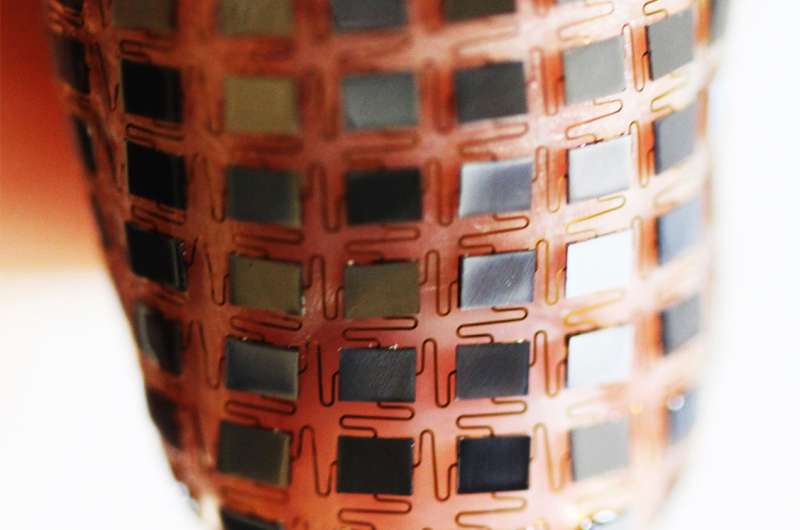May 17, 2016 report
Stretchable batteries that can be applied to the skin like a band-aid (w/ video)

(Tech Xplore)—An international team of researchers has developed a means for applying a stretchable battery to human skin that not only carries enough charge to power a portable device, but can be applied like a band-aid. In their paper published in Proceedings of the National Academy of Sciences, the team describes the technology they built, how it works and a how they combined their battery technology with tiny solar cells to build an actual working monitoring device.
Over the past couple of years, researchers around the world have developed wearable devices that offer a variety of services, but all of them suffer from one major defect—they require removal for charging their batteries. In this new effort, the researchers describe their novel approach to solving this problem.
Realizing that taping a full size battery to the skin would be unfeasible, even one as small as a pea, the team created a new type of battery by cutting an ordinary lithium ion batter into very small, very thin tiles, then tied the tiles together with wires to make one large battery. The wires and tiles were then embedded in a soft, rubbery, material and then coated with another stiffer type of rubber. The result was an extremely thin, stretchable (because the wires inside are of longer length than the span between the tiles) waterproof battery that can be applied to the skin as a mobile rechargeable battery.

To show how such a battery might work, the team built a sensory device by adding tiny solar cells on top of their battery, and some tiny bio-sensors and chips. The whole package, the team explained, can be applied to the skin like a band-aid, and will provide a never-ending stream of bio-sensor data. Testing showed that the device could be stretched up to 30 percent without losing functionality.
The researchers suggest their battery could be used in a wide variety of applications and with different types of power sources. It is not difficult to imagine it being used as a means of storing energy captured from body movement or heat for example. It could also be integrated into clothes, or even socks, allowing for sensors to capture bodily signals 24 hours a day, seven days a week, without ever having to be removed for recharging.
More information: Jung Woo Lee et al. Soft, thin skin-mounted power management systems and their use in wireless thermography, Proceedings of the National Academy of Sciences (2016). DOI: 10.1073/pnas.1605720113
Abstract
Power supply represents a critical challenge in the development of body-integrated electronic technologies. Although recent research establishes an impressive variety of options in energy storage (batteries and supercapacitors) and generation (triboelectric, piezoelectric, thermoelectric, and photovoltaic devices), the modest electrical performance and/or the absence of soft, biocompatible mechanical properties limit their practical use. The results presented here form the basis of soft, skin-compatible means for efficient photovoltaic generation and high-capacity storage of electrical power using dual-junction, compound semiconductor solar cells and chip-scale, rechargeable lithium-ion batteries, respectively. Miniaturized components, deformable interconnects, optimized array layouts, and dual-composition elastomer substrates, superstrates, and encapsulation layers represent key features. Systematic studies of the materials and mechanics identify optimized designs, including unusual configurations that exploit a folded, multilayer construct to improve the functional density without adversely affecting the soft, stretchable characteristics. System-level examples exploit such technologies in fully wireless sensors for precision skin thermography, with capabilities in continuous data logging and local processing, validated through demonstrations on volunteer subjects in various realistic scenarios.
© 2016 Tech Xplore



















